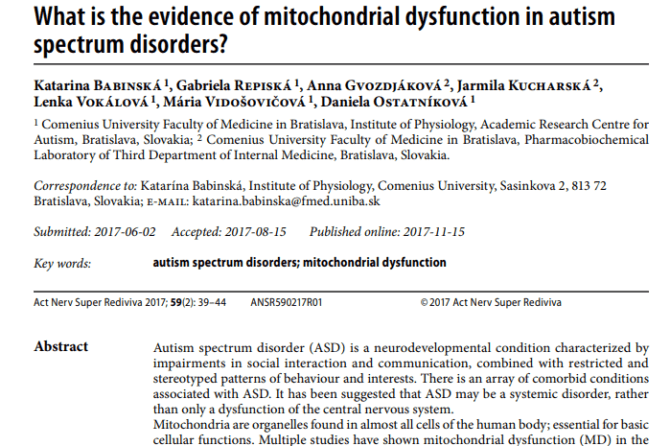
AUTHORS: Babinská, K., Repiská, G., Gvozdjáková, A., Kucharská, J., Vokálová, L., Vidošovičová, M., Ostatníková,D.
ABSTRACT: Autism spectrum disorder (ASD) is a neurodevelopmental condition characterized by impairments in social interaction and communication, combined with restricted and stereotyped patterns of behaviour and interests. There is an array of comorbid conditions associated with ASD. It has been suggested that ASD may be a systemic disorder, rather than only a dysfunction of the central nervous system. Mitochondria are organelles found in almost all cells of the human body; essential for basic cellular functions. Multiple studies have shown mitochondrial dysfunction (MD) in the brain, also in the peripheral tissues of individuals with ASD. It has been estimated that the prevalence of classic mitochondrial disease in ASD population is 5%; however, about 50% of children with ASD may present some abnormalities in markers of mitochondrial functions. Interactions between mitochondrial dysfunction and other underlying pathology of ASD were found, such as oxidative stress or immune dysregulation. Existing data indicate that mitochondrial dysfunction is implicated in pathology of ASD, at least in a subgroup of the patients. The evidence, however, is still only patchy. Advances in understanding of the involvement of mitochondrial dysfunction in ASD could be a step towards better understanding of the pathophysiology of ASD, and unravelling the role of mitochondria in ASD could open new prospectives for diagnostics and therapeutic interventions. There is a need to find a valid biomarker of mitochondrial dysfunction in ASD and to develop standardized procedures to identify the individuals with ASD and MD, who might mostly profit from an intervention.
Activitas Nervosa Superior Rediviva. – Vol. 59, No. 2 (2017), s. 39-44. – ISSN (print) 1337-933X


